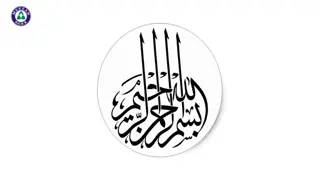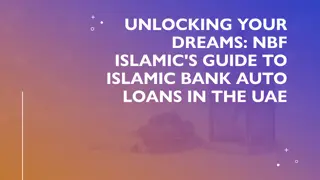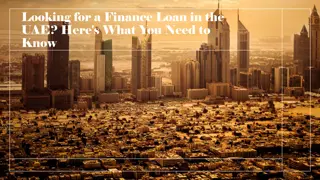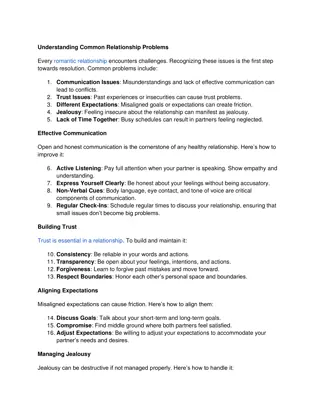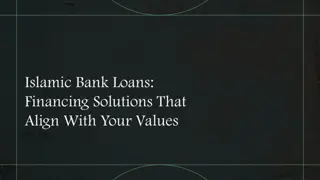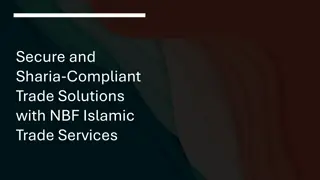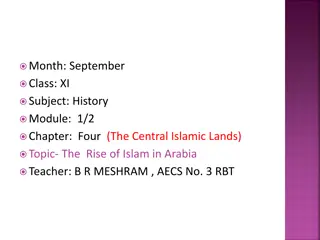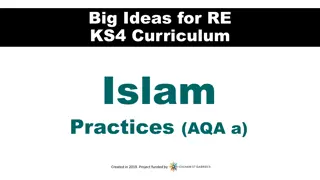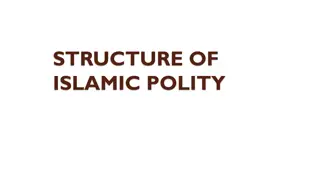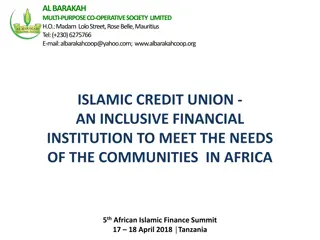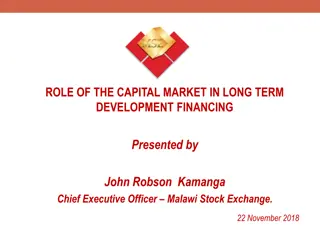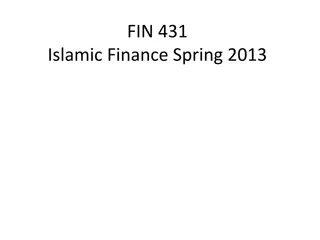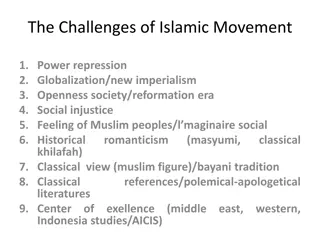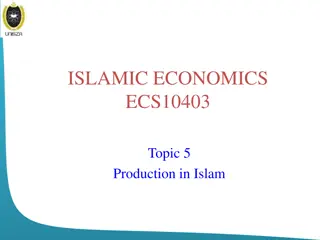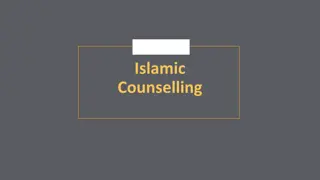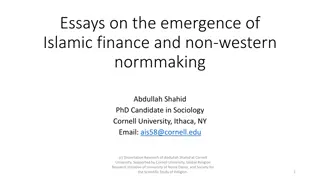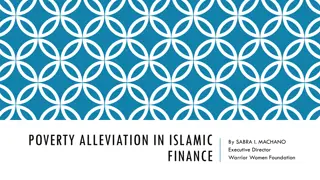Regulatory Framework for Islamic Capital Markets: Insights from BICAM Conference
Exploring the regulatory landscape of Islamic capital markets through insights shared at the BICAM Conference, focusing on international standards, best practices, and the compatibility of IOSCO principles in regulating Islamic securities.
Download Presentation

Please find below an Image/Link to download the presentation.
The content on the website is provided AS IS for your information and personal use only. It may not be sold, licensed, or shared on other websites without obtaining consent from the author. Download presentation by click this link. If you encounter any issues during the download, it is possible that the publisher has removed the file from their server.
E N D
Presentation Transcript
BRUNEI DARUSSALAM ISLAMIC CAPITAL MARKET (BICAM) CONFERENCE Capital Market and Islamic Finance: Synergies and Opportunities Zainal Izlan Zainal Abidin Securities Commission Malaysia 22 October 2018
International Standards and Best Practices for Capital Market Regulation IOSCO s Objectives and Principles of Securities Regulation Ensuring markets are fair, efficient and transparent Protection of investors Reduction of systemic risks Regulation should detect, deter and penalise market manipulation and other unfair trading Protection of misleading, manipulative and fraudulent practices Reduce risk of financial failure of market intermediaries Promote and allow effective risk management Full and timely disclosure Regulation should aim to ensure investors are given fair access to the market 3 3
No Requirement for Separate Regulation in Developing Islamic Capital Market Report of the ICM Task Force of the IOSCO (July 2004) to assess the extent of the development from a regulatory perspective and potential regulatory issues relating to ICM Analysis of the Application of IOSCO s Objectives and Principles of Securities Regulation for Islamic Securities Products (September 2008) compatibility of IOSCO s core principles with the products and practices of Islamic finance to assess the the conventional securities regulation framework and principles equally apply to the ICM, with the addition of some form of a Shariah certification process - no need to formulate separate principles for the market. By extension, objectives and principles of securities regulation can be applied to the Islamic capital market The analysis of this report has not identified any concerns with respect to the compatibility of the IOSCO Core Principles with the Islamic securities market The overall findings are broadly consistent with the findings of the Report of the ICM Task Force of the IOSCO (July 2004) approval or regulatory capital IOSCO s Islamic 4 4
Emphasis on Disclosure for both Islamic and Conventional Capital Markets conforms to IOSCO s Principles of Securities Regulations protection of investors is achieved through disclosure Accord same level of investors protection as in conventional market, e.g. process of regulation, supervision and enforcement Common regulatory approach - same liability on the part of intermediaries e.g. due diligence and representation Disclosure, transparency and governance apply equally to both Islamic and conventional products, hence same legal and regulatory protection. 5
A two-tier regulatory framework in Malaysia Tier 1: General Regulatory Requirements Tier 2: Specific Shariah Requirements Bonds Trust deed, mandatory rating, eligible persons, etc. Sukuk Approved Shariah principles, Shariah adviser, utilisation of proceeds Islamic Unit Trusts Shariah adviser, investments, annual certification by the Shariah adviser Islamic REITs Shariah adviser, tenants activities and rental income must comply with Shariah requirements Unit Trusts Investment committees, trustees, management company, etc. REITs At least 50% of investment in real property 6
Conducive ecosystem to support the development of ICM Well Developed Legal and Regulatory Framework Sound Shariah Governance Framework Facilitative Tax Framework Strong Government Support and Commitment 7
Navigating through changing global landscape Global sustainability agenda Rising affluence Market expansion Global Islamic finance in financial centres competitiveness Sustained Growth Demand for Islamic solutions Digitalisation 9
Funding for sustainable development goals UN Sustainable Development Goals (SDGs) 17 global goals to achieve integrated sustainable development covering economic, social and environmental UN estimated US$11.5tn a year or US$172.5tn over 15 years to fund the 17 SDGs 10
Green Finance Green finance is finance for a sustainable planet. It covers the gamut of financial services, institutional arrangements, country initiatives and policies, and products (debt, equity, insurance, or guarantees) designed to promote the flow of finance towards economic activities and projects - ADB Green finance products: green bonds green lending guidelines green banks carbon finance green insurance green IPOs green stock indices green credit green asset securitization Opportunities for Islamic finance Source: ADB 11
Trend in Green Bonds 2012 - 2017 USD155.5bn - total green bond issuance Over 1500 green bond issues 78% - growth on 2016 37 countries from all continents 239 different issuers 146 new issuers USD10.7bn largest single green bond 3 Sovereign Green Bonds: France, Fiji, Nigeria Source: Climate Bonds Initiative 12
Demand for green infrastructure projects Over 15 years (2016 30), global economy needs to invest around $90 trillion in infrastructure assets WB Emerging economies will account for 60 % of the global infrastructure needs between 2016 and 2030 including many member countries of the OIC WB Developing Asia will need to invest $26 trillion from 2016 to 2030, or $1.7 trillion per year, if the region is to maintain its growth momentum, eradicate poverty, and respond to climate change ADB Of the total climate-adjusted investment needs over 2016 2030, $14.7 trillion will be for power and $8.4 trillion for transport. Investments in telecommunications will reach $2.3 trillion, with water and sanitation costs at $800 billion over the period ADB 13
Global Sukuk issuances and outstanding 2012 2013 2014 2015 2016 2017 Global 131.2 119.7 118.8 66.1 2012 2013 2014 2015 2016 2017 Global 229.3 269.4 300.9 321.2 349.1 396 74.8 99.5 14
Growing commitment towards Sustainable and Responsible Investments (SRI) globally 1885 70 1501 1384 62 59 11861251 1050 890 45 734 523 361 34 32 185 63 24 21 18 13 10 6.5 Apr-06 Apr-07 Apr-08 Apr-09 Apr-10 Apr-11 Apr-12 Apr-13 Apr-14 Apr-15 Apr-16 Dec-17 Assets under management (US$ trillion) Number of Signatories Source: UN PRI US$70 trillion assets managed by 1,885 signatories to the UN PRI 15
Growing commitment towards SRI globally (cont.) Global SRI Assets (US$ trillions)* 22.9 18.3 13.3 2012 2014 2016 Source: Global Sustainable Investment Alliance (GSIA) US$22.89 trillion assets professionally managed under SRI strategies (CAGR: 11.9% over 2 years) SRI now stands at 26% of all professionally managed assets globally Negative/exclusionary screening is the largest approach with US$15.02 trillion or 65% of global SRI assets in 2016 *GSIA report is published every 2 years, with the latest published in March 2017 for 2016 reviews 16
SC introduced 5i Strategy to develop SRI ecosystem for Malaysian capital market 5i Strategy 17
Selected initiatives on developing SRI in Malaysia Sustainable & Responsible Investment (SRI) Sukuk Framework Tax deduction until year of assessment 2020 on issuance costs of SRI sukuk approved or authorised by or lodged with the SC MYR6 million Green SRI Sukuk Grant Scheme administered by Capital Markets Malaysia, to defray independent expert review costs incurred by sukuk issuers Tax exemption for recipients under the Green SRI Sukuk Grant Scheme from year of assessment 2018 to 2020 SRI Funds Framework 18
Islamic social finance Development of Waqf assets: Improves socio-economic well being Unleashes their potential market value Provides avenue for Shariah-compliant funding ICM can propel waqf development via: Asset / Fund managers Sukuk issuance Innovation & digitalisation 19
Islamic Capital Market and the UN SDGs SDG 3: Good Health & Well-Being SDG 7: Renewable Energy IFFIm Sukuk (immunisation) SDG 4: Quality Education Green Sukuk (building / solar) Sukuk Ihsan (trust schools) SDG 10: Reduced Inequalities Waqf Shares (transport terminal) 20
Combination of global trends led to opportunity for ICM. Global AUM (US$ trillion, 2008-2015) CAGR 7.5% 21 Sources: Boston Consulting Group, Pew Research Center, World Bank, SC
. in Islamic Fund & Wealth Management Securities Commission Malaysia launched the Islamic Fund and Wealth Management Blueprint in January 2017 Vision: Malaysia to be a leading international centre for Islamic fund and wealth management 3 Strategic Thrusts, with 11 recommendations to be implemented on a phased approach: 1. Strengthen Malaysia s positioning as a global hub for Islamic funds 2. Establish Malaysia as a regional centre for Shariah-compliant sustainable and responsible investments 3. Develop Malaysia as an international provider of Islamic wealth management services 22
Shariah-compliant equities & indices Annualized Returns* No. of Constituents Market Cap (in US$ trillion) 3 Years 5 Years 10 Years Dow Jones Islamic Market World Index S&P Global Broad Market Index 2,625 30.5 15.17 10.39 9.51 11,194 69.2 13.44 8.67 8.48 Source: S&P Dow Jones Indices * Net total returns As at 30 September 2018 23
Enhancing development of ICM via products & services Ensure breadth and depth of ICM products and services to be competitive with the conventional segment: Exchange-traded funds (ETFs) Provides investors/issuers greater access to diverse range of investment products Real estate investment trusts (REITS) Provides more convenient avenue to gain/increase property exposure Private equity / Venture capital Attractive source of funding for SMEs Accelerate growth and increase competitiveness of SMEs 24
Enhancing development of ICM via Digitisation Lower operating costs and wider distribution capability via Digitisation can facilitate greater inclusiveness Significant variation in financial inclusion rates: o Close to 100% in developed countries o 69% in East Asia & Pacific o 14% in Middle East Equity Crowdfunding Provides critical source of alternative financing for SMEs Addresses funding gap for start ups Digital Investment Management Expands access to investments 25
Other cross-border opportunities Standards for Green , Social & Sustainability Bonds Collective Investment Scheme (CIS) framework ASEAN IFSB 19 Guiding Principles on Disclosure Requirements for ICM Products (Sukuk and Islamic CIS) IFSB ED 21 Core Principles for Islamic Finance Regulation (ICM Segment) Regulatory Standards SC-World Bank-IOSCO Conference on Harnessing Islamic Finance for a Green Future SC-IsDB-UNDP Seminar on Achieving the SDGs through Islamic Finance (side event at UN General Assembly) Thought Leadership & Awareness 26
THANK YOU 27





